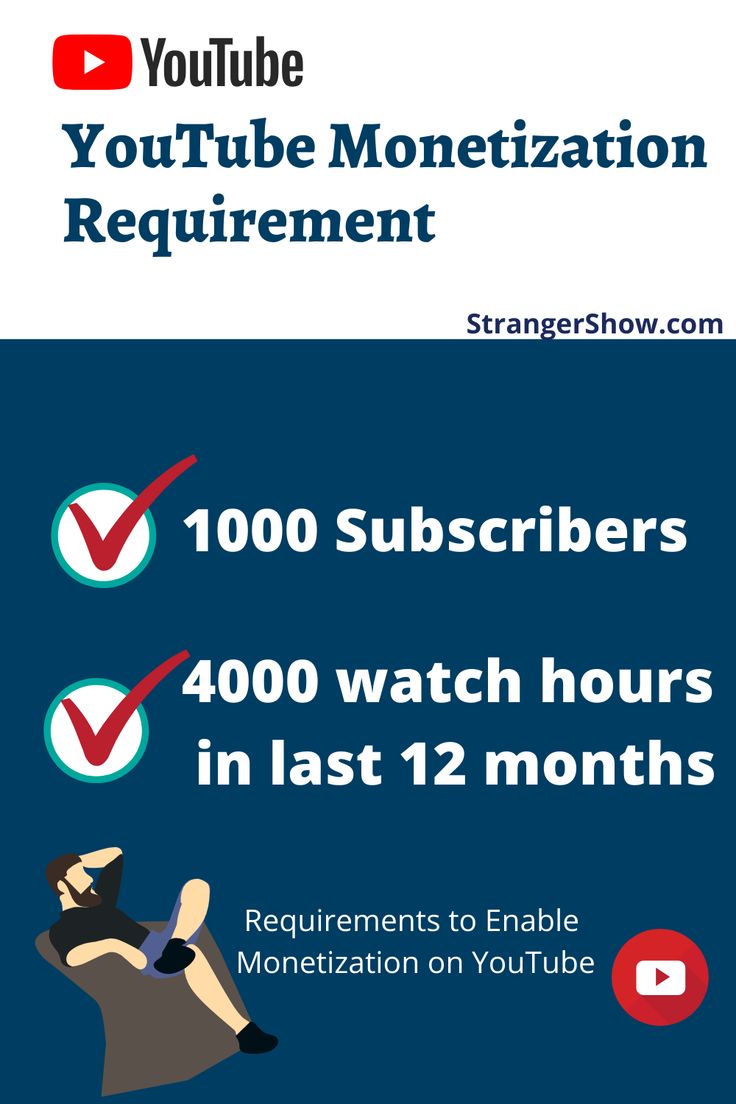YouTube monetization is an exciting avenue for content creators to turn their passions into a potential income stream. If you've ever wondered how creators earn money from their videos, you're not alone! Many have discovered that YouTube can be a lucrative platform for sharing knowledge, entertainment, or creativity. However, diving into the world of monetization can be a bit tricky. In this section, we’ll unravel the basics of
Eligibility Criteria for YouTube Monetization

So, you’re itching to start your YouTube journey and make some dough? Before you can cash in, you’ll need to check off a few eligibility boxes. YouTube has set specific requirements that every aspiring creator must meet to qualify for its Partner Program. Below is a clear breakdown of these requirements:
- 1,000 Subscribers: You need at least 1,000 subscribers on your channel. This can seem daunting, but think of it as an engaged audience who loves what you create!
- 4,000 Watch Hours: In the past 12 months, your channel must have accrued over 4,000 valid public watch hours. This means people have actually engaged with your content rather than just scrolling through.
- Adherence to Policies: Ensure that your content aligns with YouTube’s community guidelines and terms of service. This includes avoiding copyrighted material, hate speech, and inappropriate content.
- AdSense Account: You’ll need a linked AdSense account to earn money from ads. It’s a straightforward process and crucial for getting paid.
Meeting these requirements can take time and effort, but it’s all about being consistent and engaging with your audience. Once you’ve ticked off these boxes, you can start monetizing your content and potentially earn a sustainable income!
Understanding YouTube's Partner Program
The YouTube Partner Program (YPP) is your golden ticket to monetizing your content on the platform. Whether you're a budding creator or an established influencer, getting into the YPP can open up various revenue streams. But what does it really mean to be a part of this program? Let's break it down!
To qualify for the YPP, you'll need to meet certain criteria:
- 1,000 Subscribers: You need to have at least 1,000 subscribers on your channel.
- 4,000 Watch Hours: Within the past 12 months, your videos must have accumulated a total of 4,000 watch hours.
- Adherence to Guidelines: Your channel must comply with all of YouTube's policies and guidelines.
- AdSense Account: You’ll also need to set up an AdSense account to get paid once eligible.
Once you're in, the benefits are quite desirable:
- You can earn money through ads played during your videos.
- Access to YouTube Premium revenue when subscribers watch your content.
- Opportunities for channel memberships and super chats during live streams.
So why is it essential to understand YPP? It’s not just about financial gain; it’s about community building and creating engaging content that resonates with your audience. If you're serious about your YouTube journey, mastering the ins and outs of the Partner Program is a must!
How Views Impact Earnings on YouTube
Ah, the million-dollar question: How do views actually translate to earnings on YouTube? The truth is that while more views typically mean more earnings, it's not that straightforward. Let’s dive into what you need to know!
YouTube monetization works primarily through ads, which are determined by a variety of factors, including:
- Ad Placement: Ads can be placed before, during, or after videos. Generally, more ads mean more revenue, but balance here is key.
- Viewer Demographics: Advertisers pay more for views from certain demographics, especially those that are high-value markets like the U.S. or Europe.
- Engagement Metrics: High engagement (likes, comments, shares) can also lead to better ad placements and earnings.
- Content Type: Some niches naturally have higher CPMs (cost per thousand views) than others. For instance, finance or tech-related content tends to attract more lucrative sponsorships.
To give you a clearer picture, here's a rough idea of how CPM rates can vary:
| Niche | Average CPM ($) |
|---|---|
| Finance | $15 - $30 |
| Technology | $10 - $25 |
| Lifestyle | $5 - $15 |
| Gaming | $5 - $10 |
In essence, while views are vital, they are just one part of the equation. It's essential to create high-quality, engaging content that not only attracts views but also keeps your audience coming back for more. So, focus on growing your channel ethically, and the earnings will likely follow!
Factors Influencing YouTube Revenue Beyond Views
When it comes to YouTube monetization, many creators focus primarily on the number of views their videos get. However, several factors can significantly influence your overall revenue, making it crucial to look beyond just the view count. Let's break down these factors:
- Ad Types: The type of ads displayed on your videos can make a huge difference in your earnings. Advertisers may choose between skippable, non-skippable, or bumper ads, and each comes with its own payout structure. Non-skippable ads tend to generate higher revenue since viewers must watch them.
- Engagement Metrics: High engagement rates (likes, comments, shares) enhance your video's visibility, which can lead to more ad impressions. Keeping your audience engaged can also lead to better performance in YouTube’s algorithm, potentially attracting more views and higher-paying ads.
- Audience Demographics: The location and age group of your audience matter. Advertisers pay more to target specific demographics. For instance, viewers from countries with higher purchasing power tend to attract better CPM rates.
- Niche Content: Some niches naturally have higher CPMs than others. For instance, finance and technology channels typically yield higher earnings per view compared to lifestyle or entertainment videos. Knowing your niche can help you strategize your content effectively.
- Collaboration and Sponsorship: Partnering with brands or collaborating with other YouTubers can provide direct income streams outside ad revenue. Sponsored videos or affiliate marketing can significantly boost your overall earnings.
Understanding these factors can help you manage your channel more effectively and explore various income avenues beyond just focusing on the views.
Tips to Increase Views and Monetization Potential
Boosting your views and maximizing your monetization potential on YouTube can feel overwhelming, but with the right strategies, you can make a significant impact. Here are some practical tips:
- Create Quality Content: First and foremost, focus on producing high-quality, engaging content that resonates with your audience. Better content often leads to higher watch times, which in turn can improve your rankings in search results.
- Optimize Titles and Descriptions: Use catchy, descriptive titles that include relevant keywords. This not only attracts viewers but also helps in search engine optimization (SEO). Don't forget to craft a compelling description to provide context and also include keywords.
- Utilize Thumbnails: Creating eye-catching thumbnails can significantly increase your click-through rate (CTR). It’s your video’s first impression, so make it engaging and relevant.
- Engage with Your Audience: Respond to comments, ask questions, and encourage viewers to like and share your videos. Building a community can enhance retention and encourage more viewers to return for future videos.
- Leverage Social Media: Promote your videos on your social media platforms. Creating a presence on Facebook, Twitter, and Instagram can help you drive traffic to your YouTube channel.
- Collaborate with Others: Partnering with other YouTubers can help you tap into their audience, bringing new viewers to your channel. Look for creators with a similar audience size or niche for effective collaborations.
By implementing these strategies, you can enhance your channel’s visibility and monetization potential. Remember, consistency is key, so keep experimenting and refining your approach!
Understanding YouTube Monetization and View Requirements
In today's digital age, YouTube has emerged as one of the leading platforms for content creators to share their work and earn money. However, understanding how monetization works and the specific view requirements can be a bit challenging. Here’s a detailed overview.
What is YouTube Monetization?
YouTube monetization allows creators to earn money from their videos through various methods, including:
- Ad Revenue: Earnings from ads displayed on your videos.
- Channel Memberships: Monthly payments from subscribers for special perks.
- Super Chat and Super Stickers: Viewer donations during live streams.
- YouTube Premium Revenue: Earnings from YouTube Premium subscribers who watch your content.
Eligibility Requirements
To start monetizing your channel, you must meet the following requirements:
| Requirement | Details |
|---|---|
| 1,000 Subscribers | Your channel must have at least 1,000 subscribers. |
| 4,000 Watch Hours | In the past 12 months, your videos must have accumulated 4,000 watch hours. |
| Comply with Policies | Adhere to YouTube’s monetization policies and community guidelines. |
| AdSense Account | Have a linked AdSense account for revenue collection. |
Meeting these criteria will qualify you for the YouTube Partner Program, allowing you to start earning from your content. Continuous engagement and quality content creation are essential for retaining and growing your audience, which in turn boosts your monetization potential.
Conclusion: Strategies for Monetizing Your YouTube Channel
To effectively monetize your YouTube channel, focus on creating engaging content that resonates with your audience, optimize your video titles and descriptions for search, and utilize social media to promote your videos. Encourage viewer interaction and consider diversifying revenue streams through sponsorships and merchandise sales.










